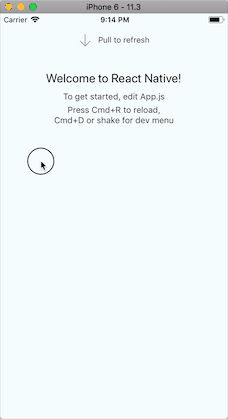协程在RN中的使用
vs
本篇并不是 ScrollView 的新轮子, 而是对比两种实现方式的差别, 来认识coroutine.
要实现的是一个对 RN 中 ScrollView 的封装, 给它添加一个隐藏的 Header, 具有下拉刷新功能.
假设你已经对 js 的 Iterators and generators有所了解.
什么是 Coroutine
function* idMaker() { let index = 0; while(true) yield index++;}let gen = idMaker();console.log(gen.next().value); // 0console.log(gen.next().value); // 1console.log(gen.next().value); // 2这是官网 generator 的栗子, yield 作为一个类似 return 的语法返回id, 下次调用 next() 时候, 继续上次位置 -> 循环 -> 继续返回新id.
The next() method also accepts a value which can be used to modify the internal state of the generator. A value passed to next() will be treated as the result of the last yield expression that paused the generator.
yield 还可以捕获 next(x) 传的参数, 所以可以根据传的不同参数, yield 代理转接不同的方法.
再举个新的栗子.
function* logTest(x) { console.log('hello, in logTest!'); while (true) { console.log('received:', yield); }}let gen = logTest();gen.next(); // hello, in logTest!gen.next(1); // received: 1gen.next('b'); // received: bgen.next({a: 1}); // received: {a: 1}这个方法中, 获取了 next 的参数, 调用 gen.next(1) 直接输出了结果.
如何自动执行 generator , 而不是手动调用 next() 呢? 使用 coroutine:
function coroutine(f) { var o = f(); // instantiate the coroutine o.next(); // execute until the first yield return function(x) { o.next(x); }}这样可以给 logTest 装备上 coroutine:
let coLogTest = coroutine(logTest); // hello, in logTest!coLogTest('abc'); // received: abccoLogTest(2); // received: 2再看个简单栗子吧:
let loginState = false;function* loginStateSwitcher() { while (true) { yield; loginState = true; console.log('Login!'); yield; loginState = false; console.log('Logout!'); }}
let switcher = coroutine(loginStateSwitcher);switcher(); // Login!switcher(); // Logout!switcher(); // Login!直接一个 switcher() 用户登录登出便捷明了.
ScrollView 下拉刷新的逻辑

可以大致看下没有使用 coroutine 的处理方式:
- 放一个
RefreshHeader到ScrollView的头上 - 绑定
onScrollBeginDrag,onScroll,onScrollEndDrag方法 - 用户开始拖拽 scrollview, 记录
_dragFlag = true和_offsetY - 用户拖拽过程中
- 判断是否为用户手动触发的
onScroll - 判断此时是否正在刷新
- 拖拽高度大于触发高度, 设置
this.state,refreshStatus为releaseToRefresh - 拖拽高度小于出发高度, 设置
this.state,refreshStatus为pullToRefresh
- 判断是否为用户手动触发的
- 用户释放手指
- 设置标志位
_dragFlag = false和记录_offsetY - 如果没在刷新, 并且刚才的状态为
releaseToRefresh, 去刷新, 设置_isRefreshing = true并且this.state,refreshStatus设置为refreshing, 调用props.onRefresh()方法, scrollView 滚动到保持刷新状态位置{ x: 0, y: -80 } - props 里的
onRefresh(onEndRefresh), 需要将结束刷新的方法回调给用户 onRefreshEnd方法里将_isRefreshing设为 false,this.state,refreshStatus设为pullToRefresh, scrollView 滚动到初始位置{ x: 0, y: 0}
- 设置标志位
可以去看下代码, 几乎所有拖拽释放逻辑分散到 onScrollBeginDrag, onScroll, onScrollEndDrag 方法中了, 如果这几个方法要共享状态就需要申请几个临时变量, 比如 _offsetY, _isRefreshing, 和 _dragFlag.
使用 coroutine 统筹管理
this.loop = coroutine(function* () { let e = {}; while (e = yield) { if ( e.type === RefreshActionType.drag && that.state.refreshStatus !== RefreshStatus.refreshing ) { while (e = yield) { if (e.type === RefreshActionType.scroll) { if (e.offsetY <= -REFRESH_VIEW_HEIGHT) { that.changeRefreshStateTo(RefreshStatus.releaseToRefresh); } else { that.changeRefreshStateTo(RefreshStatus.pullToRefresh); } } else if (e.type === RefreshActionType.release) { if (e.offsetY <= -REFRESH_VIEW_HEIGHT) { that.changeRefreshStateTo(RefreshStatus.refreshing); that.scrollToRefreshing(); that.props.onRefresh(() => { // in case the refreshing state not change setTimeout(that.onRefreshEnd, 500); }); } else { that.scrollToNormal(); } break; } } } } });只需要在相应的事件时候调用 this.loop 即可.
onScroll = (event) => { const { y } = event.nativeEvent.contentOffset; this.loop({ type: RefreshActionType.scroll, offsetY: y }); }
onScrollBeginDrag = (event) => { this.loop({ type: RefreshActionType.drag }); }
onScrollEndDrag = (event) => { const { y } = event.nativeEvent.contentOffset; this.loop({ type: RefreshActionType.release, offsetY: y }); }协程方法接受参数 {type: drag, offsetY: 0}, 用来根据当时拖拽事件和位置处理相应逻辑.
可以看到协程方法里有两个 while (e = yield):
while (e = yield) { if ( e.type === RefreshActionType.drag && that.state.refreshStatus !== RefreshStatus.refreshing) { // ..}第一个配合 if, 可以限制用户只有当第一次拖拽开始时候来开启下一步.
while (e = yield) { if (e.type === RefreshActionType.scroll) {} else if (e.type === RefreshActionType.release) {}}第二个用来处理滑动过程中和释放的事件, 这里可以肯定用户是进行了拖拽才有的事件, 于是就免去了 _dragFlag 临时变量.
当事件为 RefreshActionType.scroll, 再根据 offsetY 调用 changeRefreshStateTo() 设置当前刷新的状态为 releaseToRefresh 还是 pullToRefresh.
当事件为 RefreshActionType.release, 判断 offsetY, 如果超过触发刷新位置, 调用 changeRefreshStateTo() 设置当前刷新状态为 refreshing, 将 scrollview 固定到刷新状态的位置(否则会自动滑上去), 并且调用 props.onRefresh(); 如果不超过触发刷新位置, 则将 scrollView 滑动到初始位置(隐藏header). break 退出当前 while 循环, 继续等待下次 drag 事件到来.
<Header /> 会根据当前状态展示不同文字, 提示用户继续下拉刷新,释放刷新和刷新中, 根据刷新状态设置下尖头,上箭头还是 Loading.
PS.
setState() as a request rather than an immediate command to update the component. For better perceived performance, React may delay it, and then update several components in a single pass. React does not guarantee that the state changes are applied immediately.
一直是下拉状态的issue, 是由于setState不会立即触发改变状态导致的, 为解决这个问题, 我的处理方式是加一个半秒的延迟:
that.props.onRefresh(() => { // in case the refreshing state not change setTimeout(that.onRefreshEnd, 500);});使用 coroutine 的优点
- 逻辑清晰
- 减少不必要的变量
如果发现其他优点, 欢迎留言.
其他使用场景
如果还有见过其他使用场景, 欢迎留言.